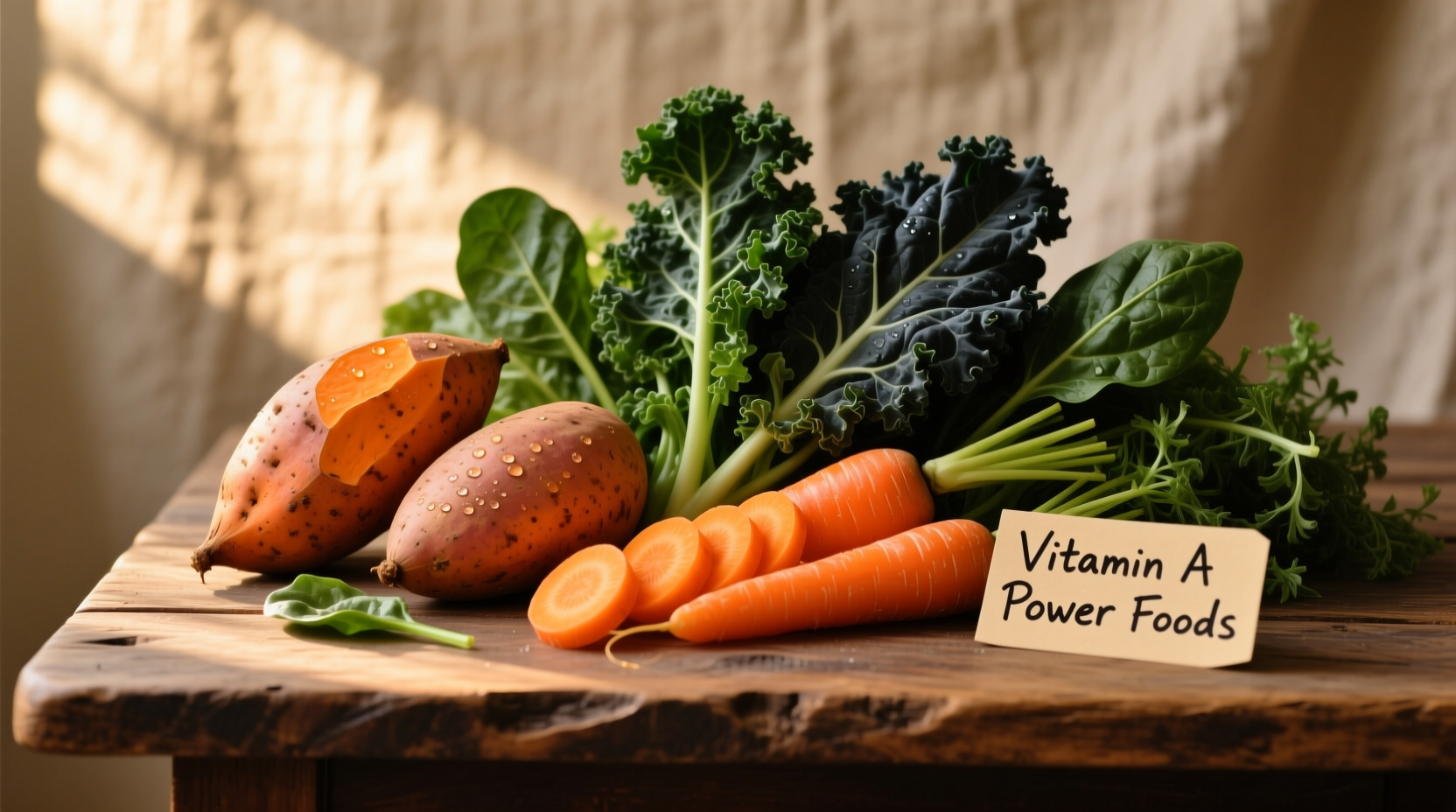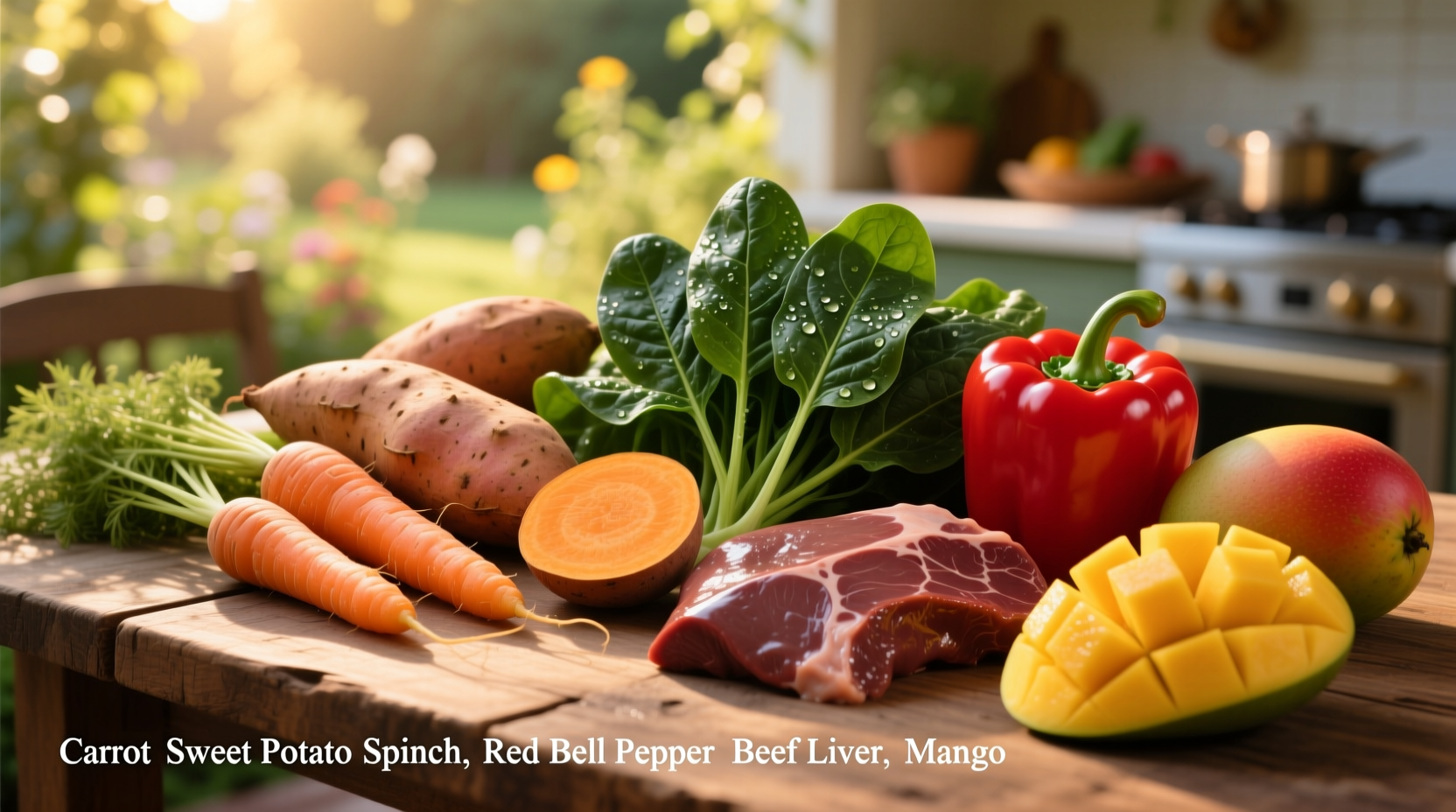Top vitamin A food sources include liver, sweet potatoes, carrots, spinach, and pumpkin. Animal sources provide preformed vitamin A (retinol), while plant sources offer provitamin A carotenoids like beta-carotene that your body converts to active vitamin A.
Discover exactly which foods contain vitamin A and how to optimize your intake for better vision, immune function, and skin health. This comprehensive guide delivers science-backed information on the best dietary sources of vitamin A, practical meal ideas, and crucial absorption tips you won't find elsewhere.
Understanding Vitamin A: Two Essential Forms
Vitamin A isn't just one compound—it exists in two primary forms that determine which foods contain vitamin A most effectively:
- Preformed vitamin A (retinol): Found in animal products, immediately usable by your body
- Provitamin A carotenoids: Plant pigments (like beta-carotene) your body converts to active vitamin A
This distinction matters because absorption rates differ significantly. Animal sources provide vitamin A your body can use directly, while plant sources require conversion that varies by individual factors like gut health and genetics.
| Food Source | Vitamin A (IU per serving) | % Daily Value | Type |
|---|---|---|---|
| Liver (beef, 3oz) | 27,170 | 543% | Retinol |
| Sweet potato (1 cup) | 19,218 | 384% | Beta-carotene |
| Carrots (1 cup) | 16,706 | 334% | Beta-carotene |
| Spinach (1 cup cooked) | 10,180 | 204% | Beta-carotene |
| Pumpkin (1 cup) | 8,025 | 161% | Beta-carotene |
| Milk (fortified, 1 cup) | 500 | 10% | Retinol |
Data sourced from the USDA FoodData Central database (2023 update). Note that conversion rates for plant-based beta-carotene to active vitamin A range from 3.6:1 to 28:1 depending on food matrix and individual factors.
Top Animal-Based Vitamin A Foods
Animal sources deliver preformed vitamin A (retinol) with superior bioavailability. Just one serving often exceeds your daily needs:
- Liver: The undisputed champion—beef liver provides over 500% of your daily vitamin A in a 3-ounce serving. Chicken and pork liver are also excellent sources.
- Fish oils: Cod liver oil contains 4,080 IU per teaspoon, making it one of the most concentrated natural sources.
- Dairy products: Fortified milk, cheese, and butter provide moderate amounts of preformed vitamin A.
- Egg yolks: One large egg delivers about 6% of your daily vitamin A needs.
According to the NIH Office of Dietary Supplements, animal sources typically have 70-90% absorption rates compared to 5-65% for plant carotenoids.
Best Plant-Based Vitamin A Sources
Plant foods provide provitamin A carotenoids, primarily beta-carotene, which your body converts to active vitamin A. These sources come with additional health benefits from fiber and phytonutrients:
- Sweet potatoes: One medium baked sweet potato contains more than 400% of your daily vitamin A needs.
- Carrots: Famous for their beta-carotene content—just half a cup provides 184% of your daily requirement.
- Dark leafy greens: Spinach, kale, and Swiss chard deliver substantial vitamin A when cooked.
- Orange and yellow vegetables: Pumpkin, butternut squash, and bell peppers are excellent sources.
- Mangoes and cantaloupe: These fruits provide significant beta-carotene along with vitamin C.

Maximizing Vitamin A Absorption
Simply eating vitamin A foods isn't enough—you need to optimize absorption. Research shows these factors significantly impact how much vitamin A your body actually uses:
- Fat is essential: Vitamin A is fat-soluble. Consuming these foods with 3-5 grams of fat increases absorption by up to 150%. Try adding olive oil to roasted vegetables or avocado to spinach salads.
- Cooking matters: Light cooking breaks down plant cell walls, releasing more beta-carotene. Steaming carrots increases beta-carotene availability by 34% compared to raw.
- Food combinations: Pairing vitamin A foods with vitamin E sources (like nuts and seeds) protects carotenoids during digestion.
- Avoid excessive alcohol: Chronic alcohol consumption impairs vitamin A metabolism and storage.
A 2022 study published in the American Journal of Clinical Nutrition demonstrated that adding 5g of avocado to a carotenoid-rich meal increased beta-carotene absorption by 283% and alpha-carotene by 398%.
Daily Vitamin A Requirements by Age and Gender
Your vitamin A needs vary throughout life. The National Academies of Sciences, Engineering, and Medicine established these daily reference intakes:
- Adult men: 900 mcg RAE (3,000 IU)
- Adult women: 700 mcg RAE (2,333 IU)
- Pregnant women: 770 mcg RAE (2,567 IU)
- Breastfeeding women: 1,300 mcg RAE (4,333 IU)
- Children (4-8 years): 400 mcg RAE (1,333 IU)
Note that RAE (Retinol Activity Equivalents) account for the different conversion rates between retinol and carotenoids. One mcg RAE equals 1 mcg of retinol or 12 mcg of beta-carotene from food.
Practical Ways to Include Vitamin A Foods Daily
Here's how to incorporate vitamin A-rich foods into your regular meals without drastic diet changes:
- Breakfast boost: Add spinach to your morning eggs or smoothie—just 1 cup cooked spinach provides 204% of your daily vitamin A.
- Lunch transformation: Replace regular potatoes with sweet potato in salads or as roasted wedges.
- Smart snacking: Keep carrot sticks with hummus at work for a vitamin A powerhouse snack.
- Dinner upgrade: Swap regular pasta for pumpkin or butternut squash puree in sauces.
- Weekly planning: Designate one dinner per week featuring liver (try chicken liver pâté if beef liver is too strong).
Important Considerations and Potential Risks
While vitamin A deficiency affects millions globally, excessive intake carries risks, particularly from preformed vitamin A sources:
- Deficiency signs: Night blindness, dry skin, frequent infections. At-risk groups include those with malabsorption conditions like Crohn's disease.
- Toxicity concerns: Consuming more than 10,000 IU daily of preformed vitamin A long-term may cause liver damage, bone pain, and birth defects. Plant-based carotenoids don't cause toxicity.
- Special populations: Pregnant women should avoid excessive liver consumption but can safely eat plant-based sources.
- Medication interactions: Vitamin A supplements may interact with acne medications like isotretinoin.
The World Health Organization reports that vitamin A deficiency remains a public health problem in over 50% of all countries, particularly affecting preschool-age children and pregnant women in Africa and Southeast Asia. However, in developed countries, deficiency is rare among those with balanced diets.
When Supplements Make Sense
For most people, food sources provide adequate vitamin A. Supplements may be appropriate in specific situations:
- Diagnosed deficiency under medical supervision
- Certain digestive disorders (celiac disease, Crohn's)
- After bariatric surgery
- Strict vegan diets with limited orange/yellow vegetables
Always consult a healthcare provider before starting vitamin A supplements, as excessive intake can cause serious health issues. Food-based sources provide vitamin A in safer, more balanced forms alongside other beneficial nutrients.











 浙公网安备
33010002000092号
浙公网安备
33010002000092号 浙B2-20120091-4
浙B2-20120091-4